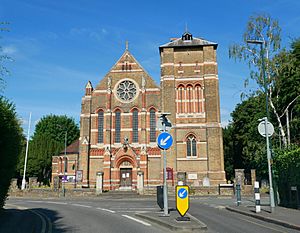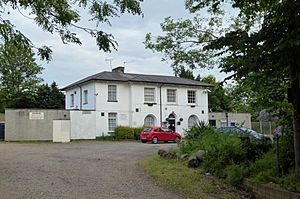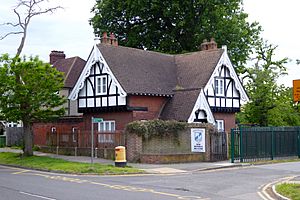Sidcup facts for kids
Quick facts for kids Sidcup |
|
|---|---|
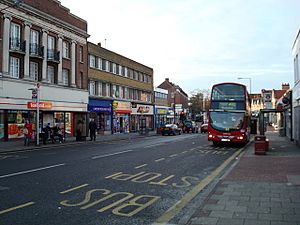 Sidcup High Street |
|
| Population | 43,109 (2011 Census) |
| OS grid reference | TQ461718 |
| London borough | |
| Ceremonial county | Greater London |
| Region | |
| Country | England |
| Sovereign state | United Kingdom |
| Post town | SIDCUP |
| Postcode district | DA14, DA15 |
| Post town | LONDON |
| Postcode district | SE9 |
| Dialling code | 020 |
| Police | Metropolitan |
| Fire | London |
| Ambulance | London |
| EU Parliament | London |
| UK Parliament |
|
| London Assembly |
|
Sidcup is an area of south-east London, England, primarily in the London Borough of Bexley. It is 11.3 miles (18.2 km) south-east of Charing Cross, bordering the London Boroughs of Bromley and Greenwich, and is in the historic county of Kent.
The name is thought to be derived from Cetecopp meaning "seat shaped or flat topped hill"; it had its earliest recorded use in 1254. The population of Sidcup, including its neighbourhoods Foots Cray, North Cray, Albany Park, Longlands, Ruxley, Blackfen and Lamorbey, was 43,109 in 2011.
Contents
History
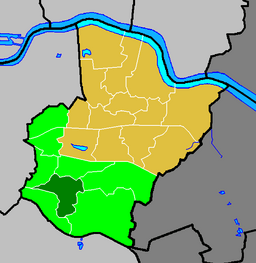
Origins
Sidcup originated as a tiny hamlet on the road from London to Maidstone. According to Edward Hasted, "Thomas de Sedcopp was owner of this estate in the 35th year of king Henry VI. [i.e. in the 1450s] as appears by his deed." Hasted described Sidcup in the latter part of the 18th century as "a small street of houses, among which is an inn of much resort", referring to the former Black Horse pub on the high street.
Sidcup parish formed the Sidcup Urban District of Kent from 1908. It was initially known as Foots Cray; however, in 1921 the urban district, and in 1925 the parish, were renamed Sidcup. The parish and district were abolished in 1934 and combined with Chislehurst to form the Chislehurst and Sidcup civil parish and urban district. In 1965 the parish and urban district were abolished. Sidcup went on to form part of the London Borough of Bexley in Greater London and Chislehurst formed part of the London Borough of Bromley.
Recent
A number of manor houses, converted to other uses, remain. They include Frognal House, the birthplace and residence of Thomas Townshend, 1st Viscount Sydney, after whom Sydney, Australia was named (now converted for use as residential and nursing accommodation), Lamorbey House (now used by Rose Bruford College), Sidcup Place (now a Brewers Fayre bar and restaurant) and "The Hollies" (now converted for residential use).
Area
Sidcup has a mixture of large Victorian and Edwardian properties alongside typical 1930s suburbia. It retains many parks and open spaces hinting at the great estates and large homes which once stood in the area.
The town contains Queen Mary's Hospital, a large Leisure Centre, four colleges and three secondary schools. Sidcup High Street is the local High Street, while there are some shops and local businesses on the adjacent Station Road. Sidcup High Street was recently the subject of a £1.8 million regeneration scheme In Store For Sidcup paid for by London Borough of Bexley.
Most of the district is within the London Borough of Bexley, however several parts in the North are under the governance of the Royal Borough of Greenwich, including Southspring, Greenhithe Close, Halfway Street (offsite Avery Hill), Radfield Way, Croyde Close and Overmead.
Demographics
In 2011 The total population was recorded as 10,844. Many residents are aged 65+ or 85+, in line with the whole of London Borough of Bexley. At the census of 2011, the non-white population of Sidcup was recorded at 10.1%; the largest minority group were Asian or Asian British (5.4% of the total population), with White Other totalling 4.8% of the total population. The number of single parent families was higher in the district in comparison to the rest of the London Borough of Bexley. 63.8% reported Christianity as their religious beliefs which was above the borough average. However, these figures do not include the Blackfen and Lamorbey wards within the district.
Sport and leisure
Sidcup has a Non-League football club Sporting Club Thamesmead F.C. who play at the Sporting Club Thamesmead. On Sydney Road, there is a Sidcup Sports Club, housing the local rugby and cricket clubs.
Sidcup also has a Leisure Centre on Hurst Road with 2 pools and a gym.
The Sidcup and District Motor Cycle Club was formed at the Station Hotel, Sidcup in 1928. The club owns the Canada Heights motorcycle sport venue in Button Street, Swanley.
Culture, identity and community
Sidcup is home to the Rose Bruford College of drama and Bird College, both of which have many well known and famous alumni and there are regular large-scale concerts given by Sidcup Symphony Orchestra, which also serves the wider South East London area.
Transport
National Rail
Sidcup station opened in October 1866, a month after the opening of the Dartford Loop Line on 1 September 1866. It is 1 mile (1.6 km) north of Sidcup town centre. The station provides the area with Southeastern services to London Charing Cross, London Cannon Street via Lewisham, Woolwich Arsenal, Dartford and Gravesend.
Roads
Sidcup High Street is on the A211, following in length the old London – Maidstone – Hythe road. The A211 starts just after Eltham High Street, in the middle running along the A20 Sidcup By-pass before ending at Foots Cray, where the B2173 continues along the former A20 road. The A211 connects the two main roads in this district; Station Road and Main Road.
East Rochester Way on the A2 road runs partly through the district, adjoining Blackfen Road. The road provides links to the Blackwall Tunnel and Kent.
Buses
Sidcup is served by a number of Transport for London bus routes, namely the 51, 160, 229, 233, 269, 286, 321, 492, 625, 669, B14 and R11. These connect Sidcup with areas including Bexleyheath, Bromley, Catford, Crayford, Chislehurst, Dartford, Eltham, Greenwich, Erith, Lewisham, New Cross, Orpington, Swanley, Thamesmead, Welling & Woolwich.
Education
Primary schools in Sidcup include: Birkbeck, Burnt Oak Junior School, Chatsworth, Days Lane, Holy Trinity Lamorbey, Longlands, Orchard School, Our Lady of the Rosary, Royal Park, Sherwood Park, and St Peter Chanel.
Secondary schools in Sidcup include Chislehurst and Sidcup Grammar School, Blackfen, Cleeve Park, Hurstmere and Kemnal Technology College.
Bird College, Christ the King: St Mary's (RC) Sixth Form College, and Rose Bruford College all have sites in Sidcup.
Notable residents
- F. Matthias Alexander (1869–1955), Australian actor and inventor of the Alexander technique, lived in Penhill House, Sidcup, for 30 years
- Harry Arter (1989–) footballer (Bournemouth F.C. and Republic of Ireland), born in Sidcup
- Steve Backley (1969–), Olympic javelin silver medallist, born in Sidcup
- Gareth Bacon, politician and leader of the Conservative Party in the Greater London Assembly
- Sam Bailey (1977–), winning contestant, The X Factor, grew up in Sidcup
- Angela Barnes (1976–) actress, stand-up comedienne, born in Sidcup
- Michael Barnard, (1976–) darts player, lived in Sidcup
- Christopher Battarbee (1975–), cricketer (Oxford University), born in Sidcup
- Lake Bell (1979–), American actress, lived in Sidcup while studying at Rose Bruford College in the 1990s.
- Doreen Bird (1928–2004), dance teacher, lived in Sidcup and established Bird College
- Quentin Blake (1932–), illustrator, artist, born in Sidcup
- Denis Bond (1946–), children's author, actor and scriptwriter, lives in Sidcup
- Tom Burns (1944–), Catholic bishop, lived and ministered in Sidcup and taught at St Mary's School in the 1970s
- Garry Bushell (1955–), journalist, lives in Sidcup
- George Albert Cairns (1913–44), recipient of the last Victoria Cross of World War II, lived and worked in Sidcup
- Sheila Callender (1914–2004), haematologist, born in Sidcup
- Ben Chorley (1982–), footballer (Tranmere Rovers, Leyton Orient, now Bromley F.C.), born in Sidcup
- Charlie Clements (1987–), actor (EastEnders), born in Sidcup
- Jason Crowe (1978–), footballer, born in Sidcup
- Jay Darlington (1968-), musician (former keyboardist for the band Kula Shaker and currently a member of the band Magic Bus), born in Sidcup
- Ian Davenport (1966–), abstract painter and former Turner Prize nominee, born in Sidcup
- Douglas Harries (1893–1972), Royal Air Force air vice-marshal and first-class cricketer
- Joe Healy (1986–), footballer who previously played in the Football League for Millwall, born in Sidcup
- Deren Ibrahim (1991–), Gibraltarian footballer, born in Sidcup
- Alfred Garth Jones (1872–1955), illustrator, spent the last years of his life in Sidcup
- John Paul Jones (1946–), bass guitarist (Led Zeppelin), born in Sidcup
- Douglas Macmillan (1884–1969), founder of Macmillan Cancer Support, lived in Knoll Road from 1924 until 1966, and also ran his charity from that address. Bexley Civic Society placed a blue plaque on the house in 2010
- Ivan Magill (1888–1986), innovative anaesthetist, worked in Sidcup
- Lee Murray (1977–), former kickboxer and mixed martial arts champion, convicted of the Securitas depot robbery, lived in Sidcup
- Emma Noble (1971–), model and actress, born in Sidcup
- Mike Rann (1953–), Premier of South Australia, politician, born in Sidcup, lived in Blackfen prior to emigrating to New Zealand with his parents
- John Regis (1966–), Olympic sprinter, lived in Sidcup
- Mark Ricketts (1984–), footballer, born in Sidcup
- Wayne Routledge (1985–), footballer, born in Sidcup
- Gerard Shelley (1891–1980), author, translator and Catholic bishop, born in Sidcup
- Nevil Shute (1899–1960), novelist and aeronautical engineer, lived in Hatherley Road from 1924 to 1930 while working at Vickers in Crayford
- Ethel Smyth (1858–1944), composer and suffragette, born in St. John's Road, Sidcup
- Thomas Townshend, 1st Viscount Sydney (1733–1800), politician and Cabinet minister, lived in Frognal House, Foots Cray
- Gordon Watson (1971–), former Sheffield Wednesday footballer, born in Sidcup
- Elizabeth Wiskemann (1899–1971), historian and journalist, born in Sidcup
- Doug Wright (1914–98), cricketer (Kent and England), born in Sidcup
Fictional residents
- In the Harold Pinter play The Caretaker, Davies repeatedly says that "all his papers" are in Sidcup, and he will return there, but is "waiting for the weather to break".
- Roderick Spode — fictional politician and fashion designer, was the 7th Earl of Sidcup in the Jeeves stories by P. G. Wodehouse.
Images for kids
See also
 In Spanish: Sidcup para niños
In Spanish: Sidcup para niños




